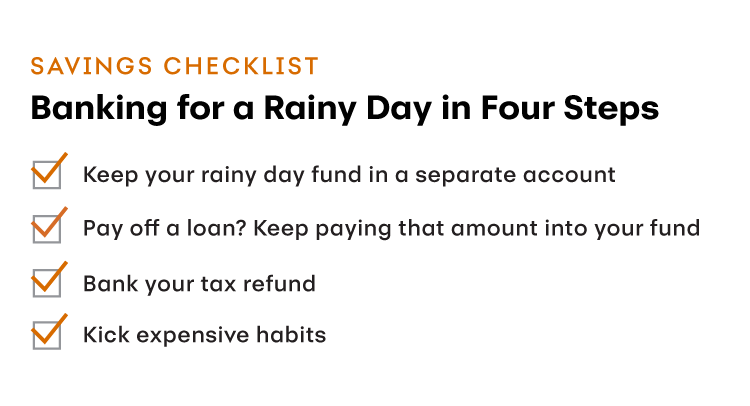On the road to building personal wealth, everyone hits a roadblock sometimes. Whether it’s an unexpected job loss or a surprise medical bill, it’s bound to strike when you least expect it—and often when you’re least prepared for it. That’s when it’s time to tap into your rainy day fund.
The classic savings account for a rainy day is designed for those unexpected misfortunes that might otherwise bring you to the precipice of a financial crisis. American savings habits, however, are no longer what they once were—and creating this financial shield in a world of shopping online, with overnight delivery, isn’t as easy as it used to be. A recent survey found that 57 million Americans don’t have any savings accounts in place for emergencies (or, for that matter, for retirement).
There are, however, a few tools that can help you keep this vital account in place when you’re tempted by a new TV or vacation.
First, make sure your rainy day fund is accessible—but not too accessible. Dan Andrews, founder of Well Rounded Success, a personal finance consulting firm based in Fort Collins, Colo., says a good way to do that is to have it at a different bank from your day-to-day checking and savings accounts. The account should hold money you can access immediately—not funds tied up in stocks, certificates of deposit or retirement accounts like 401(k)s and traditional IRAs. Good places to stash your funds include high yield savings accounts and money market accounts.
“Never see it as a piggy bank that’s tempting to break,” says Andrews. “The best way to do that is make the money out of sight, out of mind.... If you see it in or near your checking account, you’ll be more tempted to transfer it when there’s some minor cash flow interruption.”
How much should you have in a savings account for this purpose?
“I will stipulate that clients have four to six months of cash in their bank account in addition to whatever I’m managing,” says Chris White, a certified financial advisor and the author of Working with the Emotional Investor. “That makes it less likely they’ll call for distributions at an inopportune time.”
One way to jump-start your rainy day fund: When you receive a cash windfall, whether you got a tax refund or you’ve finally paid off a loan and have extra money on hand each month, funnel that into a high interest savings account until it has reached a sufficient level. Keep that four-to-six-months-of-expenses range in mind. Once you’re beyond that goal, you should consider putting the money into a retirement account, such as an IRA CD or IRA Money Market account.
If you’re carrying debt, try to get it paid off as quickly as possible. By eliminating interest payments, you’ll reach your savings goals more quickly. And even as you’re paying down that debt, notes White, you should put a small amount into the rainy day fund each week or month at the same time, to stay in the habit of contributing.
Finally, if you’ve been looking to kick an expensive habit, like smoking or drinking, establishing a high yield savings account can be a good motivation. The national average price for a pack of cigarettes is $6.16. Putting that money from a pack-a-day habit into a rainy day fund would add up to $2,248 per year. And if you live in a state where cigarettes cost a lot more—like New York, where they average $13 per pack—you could save up to $4,745.

This chart is titled "Banking for a Rainy Day in 4 Steps" Keep your rainy day fund in a separate account. Pay off a loan? Keep paying that amount into your fund. Bank your tax refund. Kick expensive habits.
Chris Morris regularly contributes to national outlets including Fortune, CNBC.com, Voice of America, Variety and Common Sense Media, as well as to dozens of other major publications.
Read next: Emergency Funds 101